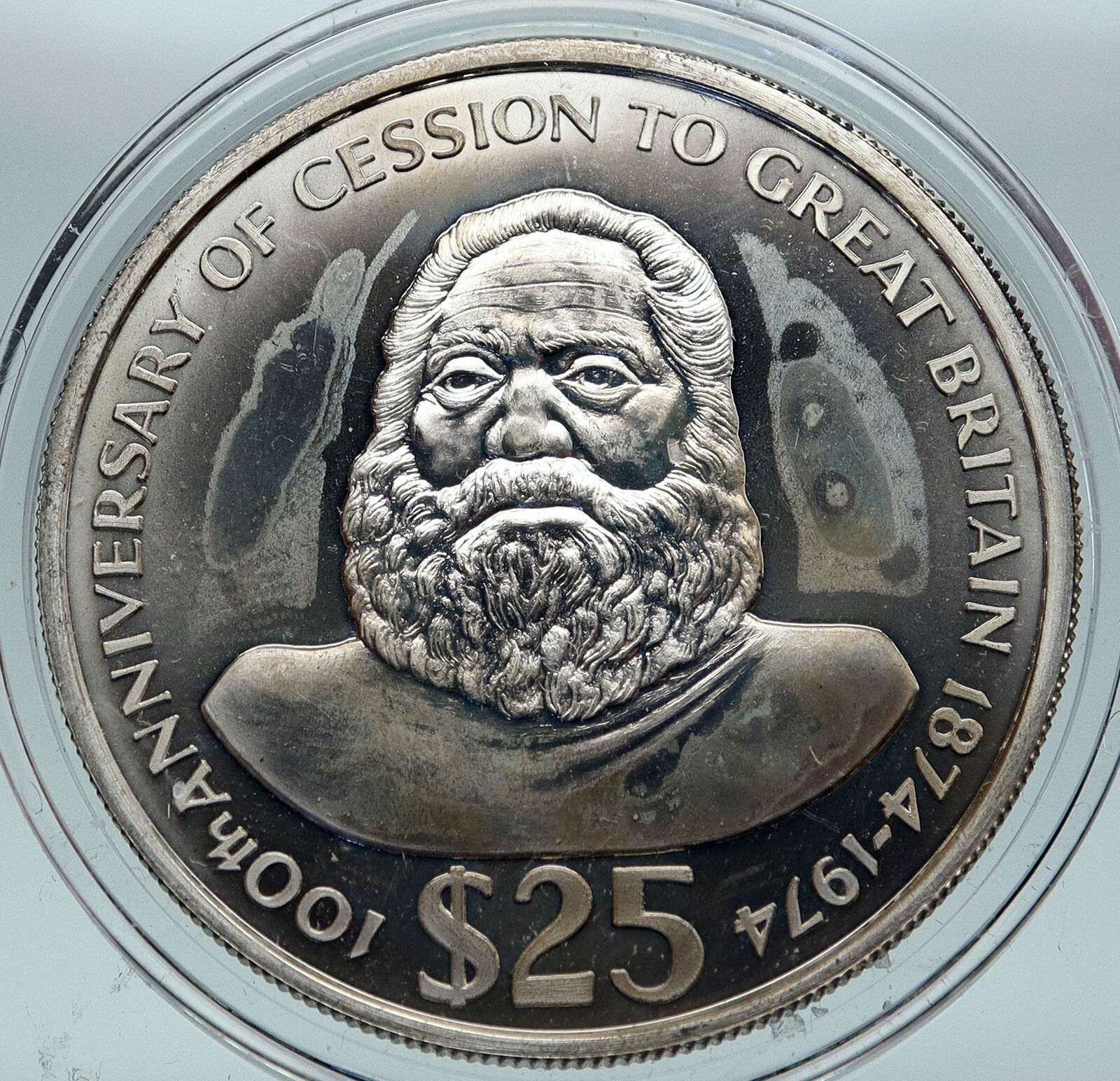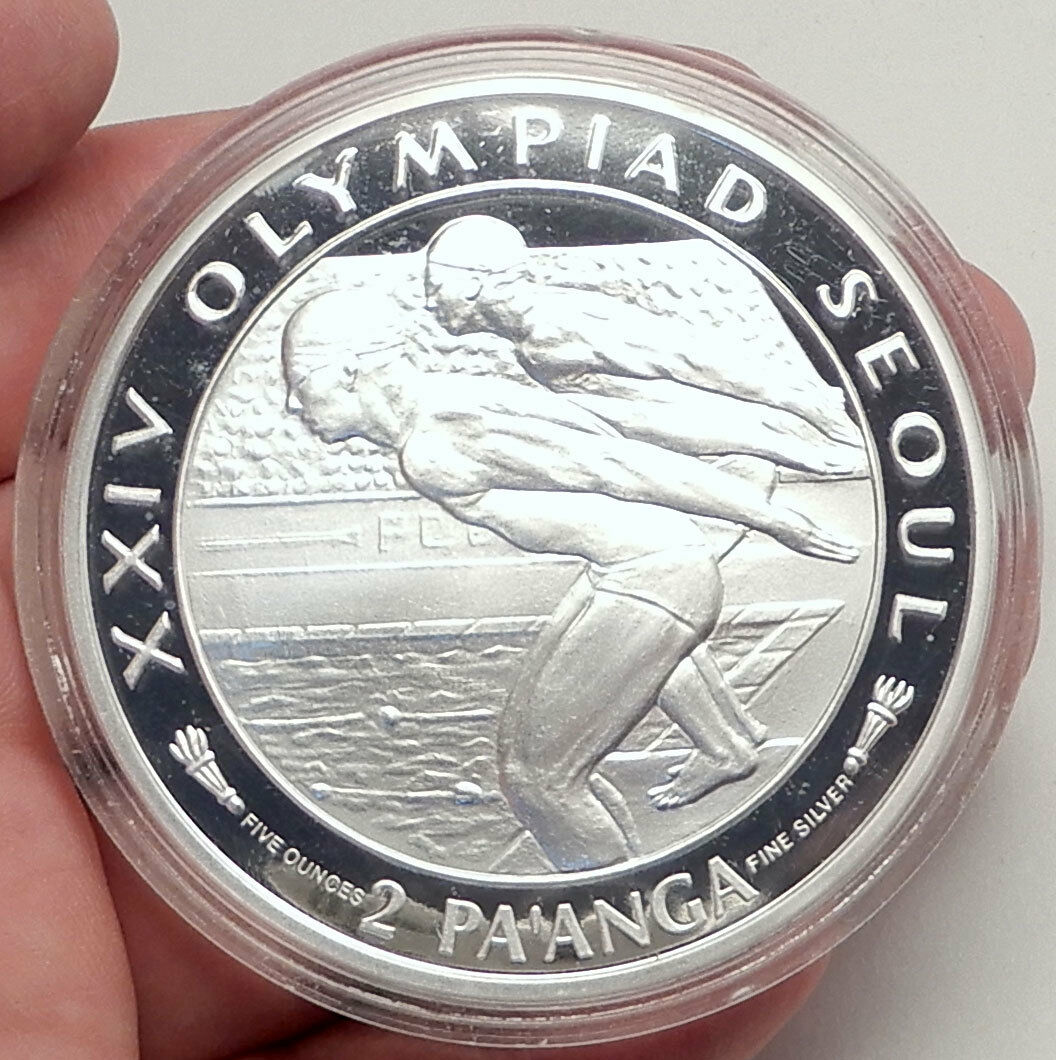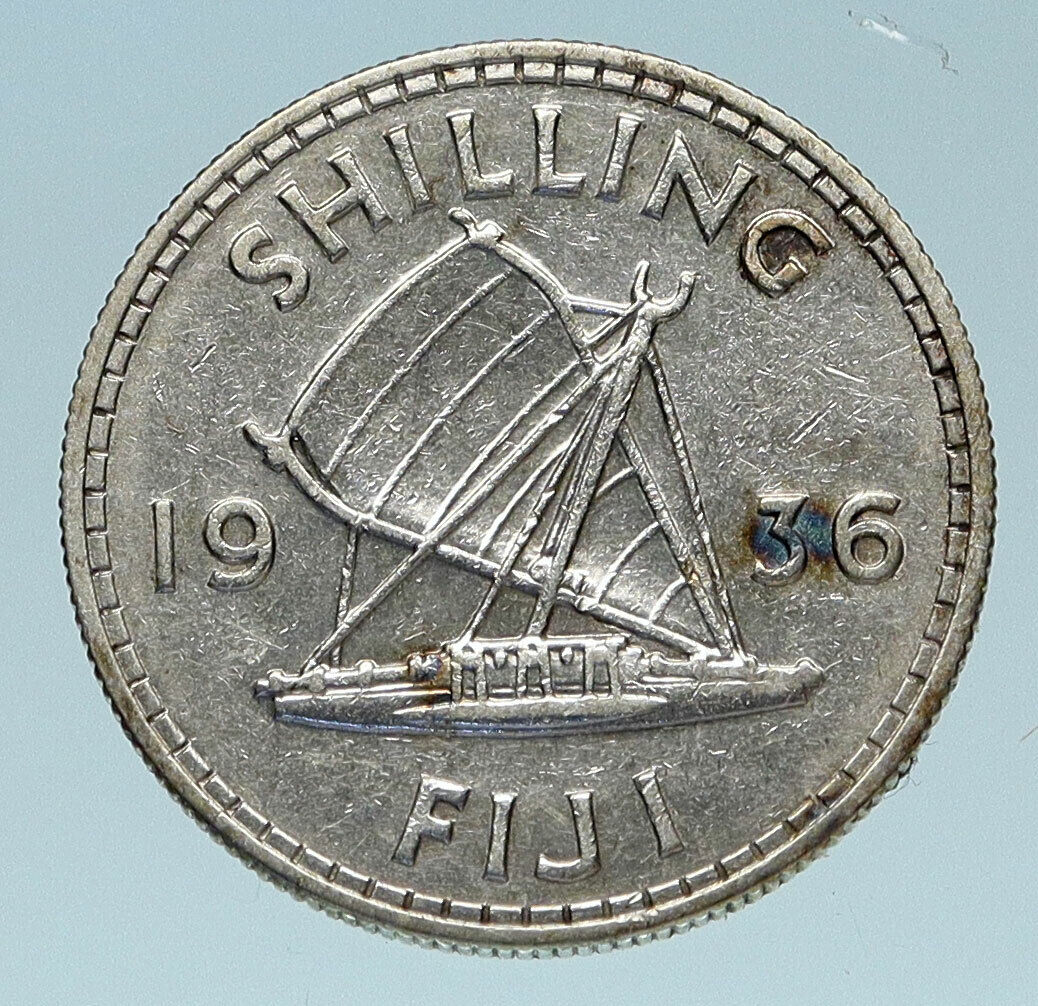|
Solomon Islands – Lunar Missions – Apollo 11 – First Lunar Vehicle
1992 Proof Silver 10 Dollars 38mm (31.30 grams) 0.925 Silver (0.9359 oz. ASW)
Reference: KM# 40
ELIZABETH II SOLOMON ISLANDS 1992, Head of Queen Elizabeth II.
FIRST LUNAR VEHICLE . 1971 10 DOLLARS, First lunar vehicle with astronaut.
You are bidding on the exact item pictured, provided with a Certificate of Authenticity and Lifetime Guarantee of Authenticity.
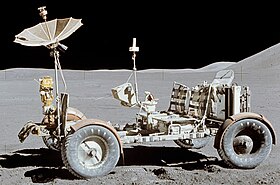 A Lunar Roving Vehicle (LRV) or lunar rover is a battery-powered four-wheeled rover used on the Moon in the last three missions of the American Apollo program during 1971 and 1972. They are popularly known as “Moon buggies“, a play on the words “dune buggy”. A Lunar Roving Vehicle (LRV) or lunar rover is a battery-powered four-wheeled rover used on the Moon in the last three missions of the American Apollo program during 1971 and 1972. They are popularly known as “Moon buggies“, a play on the words “dune buggy”.
Each of the three LRVs were transported to the Moon on the Apollo Lunar Module (LM) of each successive mission and, once unpacked on the surface, could carry two astronauts, their equipment, and lunar samples. All three LRVs remain on the Moon.
During 1965 and 1967, the Summer Conference on Lunar Exploration and Science brought together leading scientists to assess NASA’s planning for exploring the Moon and to make recommendations. One of their findings was that the LSSM was critical to a successful program and should be given major attention. At Marshall, von Braun established the Lunar Roving Task team, and in May 1969, NASA selected the Lunar Roving Vehicle (LRV) for use in manned lunar missions and approved the Manned Lunar Rover Vehicle Program as a Marshall hardware development. Saverio F. “Sonny” Morea was named the LRV program manager.
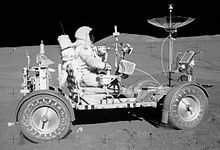 On 11 July 1969, just before the successful Moon landing of Apollo 11, a request for proposal for the final development and building the Apollo LRV was released by Marshall. Boeing, Bendix, Grumman, and Chrysler submitted proposals. Following three months of proposal evaluation and negotiations, Boeing was selected as the Apollo LRV prime contractor on 28 October 1969. Boeing would manage the LRV project under Henry Kudish in Huntsville, Alabama. As a major subcontractor, General Motors’ Defense Research Laboratories in Santa Barbara, California, would furnish the mobility system (wheels, motors, and suspension); this effort would be led by Ferenc Pavlics. Boeing in Seattle, Washington, would furnish the electronics and navigation system. Vehicle testing would take place at the Boeing facility in Kent, Washington, and the chassis manufacturing and overall assembly would be at the Boeing facility in Huntsville. On 11 July 1969, just before the successful Moon landing of Apollo 11, a request for proposal for the final development and building the Apollo LRV was released by Marshall. Boeing, Bendix, Grumman, and Chrysler submitted proposals. Following three months of proposal evaluation and negotiations, Boeing was selected as the Apollo LRV prime contractor on 28 October 1969. Boeing would manage the LRV project under Henry Kudish in Huntsville, Alabama. As a major subcontractor, General Motors’ Defense Research Laboratories in Santa Barbara, California, would furnish the mobility system (wheels, motors, and suspension); this effort would be led by Ferenc Pavlics. Boeing in Seattle, Washington, would furnish the electronics and navigation system. Vehicle testing would take place at the Boeing facility in Kent, Washington, and the chassis manufacturing and overall assembly would be at the Boeing facility in Huntsville.
The first cost-plus-incentive-fee contract to Boeing was for $19,000,000 and called for delivery of the first LRV by 1 April 1971. Cost overruns, however, led to a final cost of $38,000,000, which was about the same as NASA’s original estimate. Four lunar rovers were built, one each for Apollo missions 15, 16, and 17; and one used for spare parts after the cancellation of further Apollo missions. Other LRV models were built: a static model to assist with human factors design; an engineering model to design and integrate the subsystems; two one-sixth gravity models for testing the deployment mechanism; a one-gravity trainer to give the astronauts instruction in the operation of the rover and allow them to practice driving it; a mass model to test the effect of the rover on the LM structure, balance, and handling; a vibration test unit to study the LRV’s durability and handling of launch stresses; and a qualification test unit to study integration of all LRV subsystems. A paper by Saverio Morea gives details of the LRV system and its development.
LRVs were used for greater surface mobility during the Apollo J-class missions, Apollo 15, Apollo 16, and Apollo 17. The rover was first used on 31 July 1971, during the Apollo 15 mission. This greatly expanded the range of the lunar explorers. Previous teams of astronauts were restricted to short walking distances around the landing site due to the bulky space suit equipment required to sustain life in the lunar environment. The range, however, was operationally restricted to remain within walking distance of the lunar module, in case the rover broke down at any point. The rovers were designed with a top speed of about 8 mph (13 km/h), although Eugene Cernan recorded a maximum speed of 11.2 mph (18.0 km/h), giving him the (unofficial) lunar land-speed record.
The LRV was developed in only 17 months and performed all its functions on the Moon with no major anomalies. Scientist-astronaut Harrison Schmitt of Apollo 17 said, “The Lunar Rover proved to be the reliable, safe and flexible lunar exploration vehicle we expected it to be. Without it, the major scientific discoveries of Apollo 15, 16, and 17 would not have been possible; and our current understanding of lunar evolution would not have been possible.”
The LRVs experienced some minor problems. The rear fender extension on the Apollo 16 LRV was lost during the mission’s second extra-vehicular activity (EVA) at station 8 when John Young bumped into it while going to assist Charles Duke. The dust thrown up from the wheel covered the crew, the console, and the communications equipment. High battery temperatures and resulting high power consumption ensued. No repair attempt was mentioned.
The fender extension on the Apollo 17 LRV broke when accidentally bumped by Eugene Cernan with a hammer handle. Cernan and Schmitt taped the extension back in place, but due to the dusty surfaces, the tape did not adhere and the extension was lost after about one hour of driving, causing the astronauts to be covered with dust. For their second EVA, a replacement “fender” was made with some EVA maps, duct tape, and a pair of clamps from inside the Lunar Module that were nominally intended for the moveable overhead light. This repair was later undone so that the clamps could be taken inside for the return launch. The maps were brought back to Earth and are now on display at the National Air and Space Museum. The abrasion from the dust is evident on some portions of the makeshift fender.
The color TV camera mounted on the front of the LRV could be remotely operated by Mission Control in pan and tilt axes as well as zoom. This allowed far better television coverage of the EVA than the earlier missions. On each mission, at the conclusion of the astronauts’ stay on the surface, the commander drove the LRV to a position away from the Lunar Module so that the camera could record the ascent stage launch. The camera operator in Mission Control experienced difficulty in timing the various delays so that the LM ascent stage was in frame through the launch. On the third and final attempt (Apollo 17), the launch and ascent were successfully tracked.
NASA’s rovers, left behind, are among the artificial objects on the Moon, as are the Soviet Union’s unmanned rovers, Lunokhod 1 and Lunokhod 2.
 A Moon landing is the arrival of a spacecraft on the surface of the Moon. This includes both manned and unmanned (robotic) missions. The first human-made object to reach the surface of the Moon was the Soviet Union’s Luna 2 mission, on 13 September 1959. A Moon landing is the arrival of a spacecraft on the surface of the Moon. This includes both manned and unmanned (robotic) missions. The first human-made object to reach the surface of the Moon was the Soviet Union’s Luna 2 mission, on 13 September 1959.
The United States’ Apollo 11 was the first manned mission to land on the Moon, on 20 July 1969. There have been six manned U.S. landings (between 1969 and 1972) and numerous unmanned landings, with no soft landings happening from 22 August 1976 until 14 December 2013.
To date, the United States is the only country to have successfully conducted manned missions to the Moon, with the last departing the lunar surface in December 1972.
A total of twelve men have landed on the Moon. This was accomplished with two US pilot-astronauts flying a Lunar Module on each of six NASA missions across a 41-month period starting on 20 July 1969 UTC, with Neil Armstrong and Buzz Aldrin on Apollo 11, and ending on 14 December 1972 UTC with Gene Cernan and Jack Schmitt on Apollo 17. Cernan was the last to step off the lunar surface.
All Apollo lunar missions had a third crew member who remained on board the Command Module. The last three missions had a rover for increased mobility.
 Apollo 11 was the spaceflight that landed the first two people on the Moon. Commander Neil Armstrong and Lunar Module Pilot Buzz Aldrin, both American, landed the lunar module Eagle on July 20, 1969, at 20:17 UTC. Armstrong became the first person to step onto the lunar surface six hours after landing on July 21 at 02:56:15 UTC; Aldrin joined him about 20 minutes later. They spent about two and a quarter hours together outside the spacecraft, and collected 47.5 pounds (21.5 kg) of lunar material to bring back to Earth. Command Module Pilot Michael Collins piloted the command module Columbia alone in lunar orbit while they were on the Moon’s surface. Armstrong and Aldrin spent 21.5 hours on the lunar surface before rejoining Columbia in lunar orbit. Apollo 11 was the spaceflight that landed the first two people on the Moon. Commander Neil Armstrong and Lunar Module Pilot Buzz Aldrin, both American, landed the lunar module Eagle on July 20, 1969, at 20:17 UTC. Armstrong became the first person to step onto the lunar surface six hours after landing on July 21 at 02:56:15 UTC; Aldrin joined him about 20 minutes later. They spent about two and a quarter hours together outside the spacecraft, and collected 47.5 pounds (21.5 kg) of lunar material to bring back to Earth. Command Module Pilot Michael Collins piloted the command module Columbia alone in lunar orbit while they were on the Moon’s surface. Armstrong and Aldrin spent 21.5 hours on the lunar surface before rejoining Columbia in lunar orbit.
 Apollo 11 was launched by a Saturn V rocket from Kennedy Space Center on Merritt Island, Florida, on July 16 at 13:32 UTC, and was the fifth crewed mission of NASA’s Apollo program. The Apollo spacecraft had three parts: a command module (CM) with a cabin for the three astronauts, and the only part that returned to Earth; a service module (SM), which supported the command module with propulsion, electrical power, oxygen, and water; and a lunar module (LM) that had two stages – a descent stage for landing on the Moon, and an ascent stage to place the astronauts back into lunar orbit. Apollo 11 was launched by a Saturn V rocket from Kennedy Space Center on Merritt Island, Florida, on July 16 at 13:32 UTC, and was the fifth crewed mission of NASA’s Apollo program. The Apollo spacecraft had three parts: a command module (CM) with a cabin for the three astronauts, and the only part that returned to Earth; a service module (SM), which supported the command module with propulsion, electrical power, oxygen, and water; and a lunar module (LM) that had two stages – a descent stage for landing on the Moon, and an ascent stage to place the astronauts back into lunar orbit.
After being sent to the Moon by the Saturn V’s third stage, the astronauts separated the spacecraft from it and traveled for three days until they entered lunar orbit. Armstrong and Aldrin then moved into Eagle and landed in the Sea of Tranquillity. The astronauts used Eagle‘s ascent stage to lift off from the lunar surface and rejoin Collins in the command module. They jettisoned Eagle before they performed the maneuvers that blasted them out of lunar orbit on a trajectory back to Earth. They returned to Earth and splashed down in the Pacific Ocean on July 24 after more than eight days in space.
Armstrong’s first step onto the lunar surface was broadcast on live TV to a worldwide audience. He described the event as “one small step for [a] man, one giant leap for mankind.” Apollo 11 effectively ended the Space Race and fulfilled a national goal proposed in 1961 by President John F. Kennedy: “before this decade is out, of landing a man on the Moon and returning him safely to the Earth.”
 Solomon Islands is a sovereign state consisting of six major islands and over 900 smaller islands in Oceania lying to the east of Papua New Guinea and northwest of Vanuatu and covering a land area of 28,400 square kilometres (11,000 sq mi). The country’s capital, Honiara, is located on the island of Guadalcanal. The country takes its name from the Solomon Islands archipelago, which is a collection of Melanesian islands that also includes the North Solomon Islands (part of Papua New Guinea), but excludes outlying islands, such as Rennell and Bellona, and the Santa Cruz Islands. Solomon Islands is a sovereign state consisting of six major islands and over 900 smaller islands in Oceania lying to the east of Papua New Guinea and northwest of Vanuatu and covering a land area of 28,400 square kilometres (11,000 sq mi). The country’s capital, Honiara, is located on the island of Guadalcanal. The country takes its name from the Solomon Islands archipelago, which is a collection of Melanesian islands that also includes the North Solomon Islands (part of Papua New Guinea), but excludes outlying islands, such as Rennell and Bellona, and the Santa Cruz Islands.
 The islands have been inhabited for thousands of years. In 1568, the Spanish navigator Álvaro de Mendaña was the first European to visit them, naming them the Islas Salomón. Britain defined its area of interest in the Solomon Islands archipelago in June 1893, when Captain Gibson R.N., of HMS Curacoa, declared the southern Solomon Islands a British protectorate. During World War II, the Solomon Islands campaign (1942-1945) saw fierce fighting between the United States and the Empire of Japan, such as in the Battle of Guadalcanal. The islands have been inhabited for thousands of years. In 1568, the Spanish navigator Álvaro de Mendaña was the first European to visit them, naming them the Islas Salomón. Britain defined its area of interest in the Solomon Islands archipelago in June 1893, when Captain Gibson R.N., of HMS Curacoa, declared the southern Solomon Islands a British protectorate. During World War II, the Solomon Islands campaign (1942-1945) saw fierce fighting between the United States and the Empire of Japan, such as in the Battle of Guadalcanal.
.svg/250px-Solomon_Islands_on_the_globe_(Oceania_centered).svg.png) The official name of the then British administration was changed from “the British Solomon Islands Protectorate” to “the Solomon Islands” in 1975, and self-government was achieved the year after. Independence was obtained in 1978 and the name changed to just “Solomon Islands”, without the “the”. Today, the sovereign state is a constitutional monarchy with the Queen of Solomon Islands, currently Queen Elizabeth II, as its head of state. Rick Houenipwela is the current prime minister. The official name of the then British administration was changed from “the British Solomon Islands Protectorate” to “the Solomon Islands” in 1975, and self-government was achieved the year after. Independence was obtained in 1978 and the name changed to just “Solomon Islands”, without the “the”. Today, the sovereign state is a constitutional monarchy with the Queen of Solomon Islands, currently Queen Elizabeth II, as its head of state. Rick Houenipwela is the current prime minister.
Solomon Islands is an island nation that lies east of Papua New Guinea and consists of many islands: Choiseul, the Shortland Islands; the New Georgia Islands; Santa Isabel; the Russell Islands; Nggela (the Florida Islands); Malaita; Guadalcanal; Sikaiana; Maramasike; Ulawa; Uki; Makira (San Cristobal); Santa Ana; Rennell and Bellona; the Santa Cruz Islands and the remote, tiny outliers, Tikopia, Anuta, Fatutaka and Falkie Atoll.
The country’s islands lie between latitudes 5° and 13°S, and longitudes 155° and 169°E. The distance between the westernmost and easternmost islands is about 1,500 kilometres (930 mi). The Santa Cruz Islands (of which Tikopia is part) are situated north of Vanuatu and are especially isolated at more than 200 kilometres (120 mi) from the other islands. Bougainville is geographically part of the Solomon Islands archipelago but politically part of Papua New Guinea. Falkie Atoll, which is closer to Bougainville than to Choiseul, is part of the nation of Solomon Islands.
|





 A Lunar Roving Vehicle (LRV) or lunar rover is a battery-powered four-wheeled rover used on the Moon in the last three missions of the American Apollo program during 1971 and 1972. They are popularly known as “Moon buggies“, a play on the words “dune buggy”.
A Lunar Roving Vehicle (LRV) or lunar rover is a battery-powered four-wheeled rover used on the Moon in the last three missions of the American Apollo program during 1971 and 1972. They are popularly known as “Moon buggies“, a play on the words “dune buggy”.  On 11 July 1969, just before the successful Moon landing of Apollo 11, a request for proposal for the final development and building the Apollo LRV was released by Marshall. Boeing, Bendix, Grumman, and Chrysler submitted proposals. Following three months of proposal evaluation and negotiations, Boeing was selected as the Apollo LRV prime contractor on 28 October 1969. Boeing would manage the LRV project under Henry Kudish in Huntsville, Alabama. As a major subcontractor, General Motors’ Defense Research Laboratories in Santa Barbara, California, would furnish the mobility system (wheels, motors, and suspension); this effort would be led by Ferenc Pavlics. Boeing in Seattle, Washington, would furnish the electronics and navigation system. Vehicle testing would take place at the Boeing facility in Kent, Washington, and the chassis manufacturing and overall assembly would be at the Boeing facility in Huntsville.
On 11 July 1969, just before the successful Moon landing of Apollo 11, a request for proposal for the final development and building the Apollo LRV was released by Marshall. Boeing, Bendix, Grumman, and Chrysler submitted proposals. Following three months of proposal evaluation and negotiations, Boeing was selected as the Apollo LRV prime contractor on 28 October 1969. Boeing would manage the LRV project under Henry Kudish in Huntsville, Alabama. As a major subcontractor, General Motors’ Defense Research Laboratories in Santa Barbara, California, would furnish the mobility system (wheels, motors, and suspension); this effort would be led by Ferenc Pavlics. Boeing in Seattle, Washington, would furnish the electronics and navigation system. Vehicle testing would take place at the Boeing facility in Kent, Washington, and the chassis manufacturing and overall assembly would be at the Boeing facility in Huntsville.  A Moon landing is the arrival of a spacecraft on the surface of the Moon. This includes both manned and unmanned (robotic) missions. The first human-made object to reach the surface of the Moon was the Soviet Union’s Luna 2 mission, on 13 September 1959.
A Moon landing is the arrival of a spacecraft on the surface of the Moon. This includes both manned and unmanned (robotic) missions. The first human-made object to reach the surface of the Moon was the Soviet Union’s Luna 2 mission, on 13 September 1959.  Apollo 11 was the spaceflight that landed the first two people on the Moon. Commander Neil Armstrong and Lunar Module Pilot Buzz Aldrin, both American, landed the lunar module Eagle on July 20, 1969, at 20:17 UTC. Armstrong became the first person to step onto the lunar surface six hours after landing on July 21 at 02:56:15 UTC; Aldrin joined him about 20 minutes later. They spent about two and a quarter hours together outside the spacecraft, and collected 47.5 pounds (21.5 kg) of lunar material to bring back to Earth. Command Module Pilot Michael Collins piloted the command module Columbia alone in lunar orbit while they were on the Moon’s surface. Armstrong and Aldrin spent 21.5 hours on the lunar surface before rejoining Columbia in lunar orbit.
Apollo 11 was the spaceflight that landed the first two people on the Moon. Commander Neil Armstrong and Lunar Module Pilot Buzz Aldrin, both American, landed the lunar module Eagle on July 20, 1969, at 20:17 UTC. Armstrong became the first person to step onto the lunar surface six hours after landing on July 21 at 02:56:15 UTC; Aldrin joined him about 20 minutes later. They spent about two and a quarter hours together outside the spacecraft, and collected 47.5 pounds (21.5 kg) of lunar material to bring back to Earth. Command Module Pilot Michael Collins piloted the command module Columbia alone in lunar orbit while they were on the Moon’s surface. Armstrong and Aldrin spent 21.5 hours on the lunar surface before rejoining Columbia in lunar orbit.  Apollo 11 was launched by a Saturn V rocket from Kennedy Space Center on Merritt Island, Florida, on July 16 at 13:32 UTC, and was the fifth crewed mission of NASA’s Apollo program. The Apollo spacecraft had three parts: a command module (CM) with a cabin for the three astronauts, and the only part that returned to Earth; a service module (SM), which supported the command module with propulsion, electrical power, oxygen, and water; and a lunar module (LM) that had two stages – a descent stage for landing on the Moon, and an ascent stage to place the astronauts back into lunar orbit.
Apollo 11 was launched by a Saturn V rocket from Kennedy Space Center on Merritt Island, Florida, on July 16 at 13:32 UTC, and was the fifth crewed mission of NASA’s Apollo program. The Apollo spacecraft had three parts: a command module (CM) with a cabin for the three astronauts, and the only part that returned to Earth; a service module (SM), which supported the command module with propulsion, electrical power, oxygen, and water; and a lunar module (LM) that had two stages – a descent stage for landing on the Moon, and an ascent stage to place the astronauts back into lunar orbit.  Solomon Islands is a sovereign state consisting of six major islands and over 900 smaller islands in Oceania lying to the east of Papua New Guinea and northwest of Vanuatu and covering a land area of 28,400 square kilometres (11,000 sq mi). The country’s capital, Honiara, is located on the island of Guadalcanal. The country takes its name from the Solomon Islands archipelago, which is a collection of Melanesian islands that also includes the North Solomon Islands (part of Papua New Guinea), but excludes outlying islands, such as Rennell and Bellona, and the Santa Cruz Islands.
Solomon Islands is a sovereign state consisting of six major islands and over 900 smaller islands in Oceania lying to the east of Papua New Guinea and northwest of Vanuatu and covering a land area of 28,400 square kilometres (11,000 sq mi). The country’s capital, Honiara, is located on the island of Guadalcanal. The country takes its name from the Solomon Islands archipelago, which is a collection of Melanesian islands that also includes the North Solomon Islands (part of Papua New Guinea), but excludes outlying islands, such as Rennell and Bellona, and the Santa Cruz Islands.  The islands have been inhabited for thousands of years. In 1568, the Spanish navigator Álvaro de Mendaña was the first European to visit them, naming them the Islas Salomón. Britain defined its area of interest in the Solomon Islands archipelago in June 1893, when Captain Gibson R.N., of HMS Curacoa, declared the southern Solomon Islands a British protectorate. During World War II, the Solomon Islands campaign (1942-1945) saw fierce fighting between the United States and the Empire of Japan, such as in the Battle of Guadalcanal.
The islands have been inhabited for thousands of years. In 1568, the Spanish navigator Álvaro de Mendaña was the first European to visit them, naming them the Islas Salomón. Britain defined its area of interest in the Solomon Islands archipelago in June 1893, when Captain Gibson R.N., of HMS Curacoa, declared the southern Solomon Islands a British protectorate. During World War II, the Solomon Islands campaign (1942-1945) saw fierce fighting between the United States and the Empire of Japan, such as in the Battle of Guadalcanal. .svg/250px-Solomon_Islands_on_the_globe_(Oceania_centered).svg.png) The official name of the then British administration was changed from “the British Solomon Islands Protectorate” to “the Solomon Islands” in 1975, and self-government was achieved the year after. Independence was obtained in 1978 and the name changed to just “Solomon Islands”, without the “the”. Today, the sovereign state is a constitutional monarchy with the Queen of Solomon Islands, currently Queen Elizabeth II, as its head of state. Rick Houenipwela is the current prime minister.
The official name of the then British administration was changed from “the British Solomon Islands Protectorate” to “the Solomon Islands” in 1975, and self-government was achieved the year after. Independence was obtained in 1978 and the name changed to just “Solomon Islands”, without the “the”. Today, the sovereign state is a constitutional monarchy with the Queen of Solomon Islands, currently Queen Elizabeth II, as its head of state. Rick Houenipwela is the current prime minister. 

